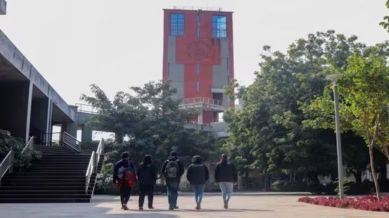Stay updated with the latest - Click here to follow us on Instagram
IITGN researchers develop ultra-thin insulator for advanced semiconductor devices
The new material offers performance suited for high-speed, low power semiconductor devices, according to researchers

As semiconductor technology advances, transistors — the tiny switches controlling electrical signals — are becoming increasingly sophisticated, powering everything from smartphones to satellites. However, the growing demand for faster and more energy-efficient electronics poses a significant challenge: designing materials that enable transistors to maintain their speed, efficiency, and reliability as they scale down. Recently, researchers at the Indian Institute of Technology Gandhinagar (IITGN), in collaboration with Penn State University, have made a breakthrough in developing an ultra-thin insulating material that could potentially address this challenge.
Made from nanosheets of titanium diboride (TiB₂), the material offers high electrical performance and can be produced through a simple, scalable process, making it suitable for large-scale manufacturing, said the researchers.
monthly limit of free stories.
with an Express account.
Chemical Engineering Department Professor and the principal investigator of the research, Dr Kabeer Jasuja, said that the work also aligns with the semiconductor industry’s ongoing “More Moore” strategy, which focuses on extending transistor miniaturisation to increase chip performance.
“Our material offers a rare combination of high electrical performance, thermal stability, and manufacturing scalability,” he said in a statement issued by IITGN.
“It is a potential candidate for integration into advanced semiconductor manufacturing, enabling faster, and more energy-efficient devices,” he said.
The research team claimed that the results of the studies confirmed that the material maintained its strong switching performance and minimal energy loss even on these large-area films, showing its potential to move seamlessly from laboratory prototypes to manufacturing environments.Their study has been recently published in the ACS Nano journal. “As transistors are miniaturised owing to the reduction in size of modern electronics, there is a need to design insulating materials thin enough for precise control of conductivity, yet robust enough to prevent electrical leakage that shortens the device’s lifespan,” Prof Jasuja added.
According to the team, unlike conventional materials, the material they have discovered is capable of striking this right balance.
“It achieved an equivalent oxide thickness (EOT) of about two nanometres despite its physical thickness being more than fifty nanometres,” said Dr Saptarshi Das, Professor of Engineering at Penn State University, whose lab carried out the electronic studies.
EOT is a way of comparing dielectric performance to silicon dioxide, the standard insulating material used in transistors. A low EOT means the dielectric can control current as effectively as a very thin layer, while the greater physical thickness provides mechanical stability and reduces leakage.
“This unique combination provides the dielectric with the precision of an ultrathin insulator while maintaining the durability and leakage resistance of a thick film, a balance rarely achieved in semiconductor devices,” he added.
Speaking about the production of the TiB₂ nanosheets, Dr Anshul Rasyotra, first author of the study and former PhD student at IITGN, described the use of a simple, room-temperature process called dissolution–recrystallisation.
As part of his IITGN Overseas Research Experience, Dr Rasyotra visited the lab of Dr Saptarshi Das at Penn State to conduct electronic studies on the nanosheets synthesised at IITGN. This method allowed them to transform bulk TiB₂ powder into sheets tens of thousands of times thinner than a human hair, without the need for high-temperature treatments or complex equipment.
Dr Jasuja elaborated, “Beyond its simplicity, the method is cost-effective, environment-friendly, and scalable. Overcoming scalability has been a major bottleneck in translating new dielectric technologies into real-world use. Our approach could enable wider adoption among research and for industrial groups that rely on large-area, cost-effective semiconductor manufacturing.”
The research team included Anshul Rasyotra, Mayukh Das, Dipanjan Sen, Zhiyu Zhang, Andrew Pannone, Chen Chen, Joan M. Redwing, Yang Yang, Prof Kabeer Jasuja, and Prof Saptarshi Das.